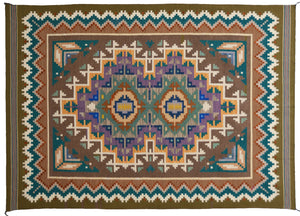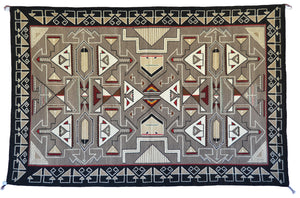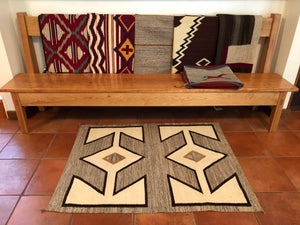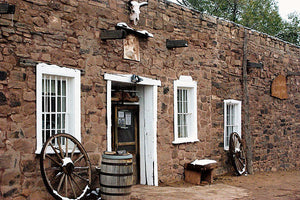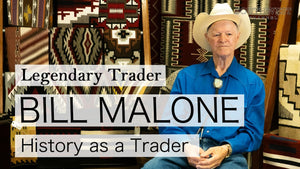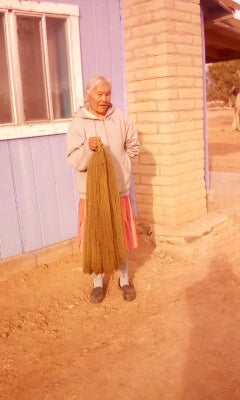Hogans - The Center of the Navajo World


The ancient hogan, known as the "forked stick hogan" was a conical hut constructed of three forked poles covered with logs, brush and mud. Called the "male" hogan by the Navajos, examples of this swelling can still occasionally be found in the western part of the reservation. More common today is the "female" hogan, a circular or 6 sided dwelling constructed of logs or stone, with a doorway facing east and a smoke hole in the center of the roof.

The dome-shaped roof is formed of cribbed logs covered with dirt. The fire is placed on the hard-packed floor beneath the smoke hole and a flap or hinged door covers the doorway. Traditionally the hogan lacked windows and was ventilated by the smoke hole in the roof and the east-facing doorway. Nowadays not only do the hogans have windows but they may also contain stoves, chimneys, beds, and refrigerators and TVs,

Today white prototype houses and even mobile homes are common on the reservation, but families that live in such dwellings also construct a hogan nearby. Many of the People have retained their native religion and Navajo ceremonies can be conducted only in a hogan.

Most Navajo families own 2, 3, or several hogans and more than one permanent establishment if they own sheep. A family that owns several hundred sheep and other livestock might have as many as 5 or 6 separate clusters of buildings scattered over a large area as the animals must be moved from place to place at various seasons of the year.

Variations in the weather and the water supply may require that a family live in one place during the summer and another during the winter. Usually though, each family has one location which is their main residence at which there are more or less permanent corrals, storage dugouts, several hogans and temporary shades or bush hogans for summer use.
The Navajo hogan is more than just a place to eat and sleep and the concept of it as a "home" bears little resemblance to a white person's attitude toward his dwelling place. The hogan is a gift of the gods and as such it occupies a place in the sacred world. The first hogans were built by the Holy People of turquoise, white shell, jet, and abalone shell. The round hogan is symbolic of the sun and its door faces east so that the first thing that a Navajo family sees in the morning is the rising sun, Father Sun, one of the most revered of the Navajo deities. The construction of a new hogan is almost always a community affair. Once completed, the new hogan is consecrated with a Blessing Way ceremony whereby the Holy People are asked to "let this place be happy."
 Also nearby, but out of sight, will be at least one sweat hogan. The sweat hogan is small scale replica of the old-style forked stick hogan but without the smoke hole. It is constructed of three sticks with forked ends which are fasten together in a tripod. Two straight sticks are leaned against the apes from the east to make the sides of the door. It is heated by placing hot rocks within, the door being closed with several blankets. The sweat hogan provides excellent bathing and purifying facilities for the Navajos in their land of scarce water. As in virtually everything a Navajo does, there are prescribed rituals that must be followed in taking a sweat bath. Four verses of the Sweat Bath Song must be sung before a Navajo can leave the sweat hogan, which the Navajo call the Son of the She Dark, to plunge into cold water or dry himself in the sand.
Also nearby, but out of sight, will be at least one sweat hogan. The sweat hogan is small scale replica of the old-style forked stick hogan but without the smoke hole. It is constructed of three sticks with forked ends which are fasten together in a tripod. Two straight sticks are leaned against the apes from the east to make the sides of the door. It is heated by placing hot rocks within, the door being closed with several blankets. The sweat hogan provides excellent bathing and purifying facilities for the Navajos in their land of scarce water. As in virtually everything a Navajo does, there are prescribed rituals that must be followed in taking a sweat bath. Four verses of the Sweat Bath Song must be sung before a Navajo can leave the sweat hogan, which the Navajo call the Son of the She Dark, to plunge into cold water or dry himself in the sand.
On the edge of the hole where they come up,
He put down the Son of the She Dark.
He built it of valuable soft materials.
Everlasting and peaceful, he put it there.
He put it there."
--- A Verse of the Navajo Sweat Bath Song
The bather then reenters the sweat hogan and sings four more verses of the song. He repeats the ritual until the entire song has been sung. - Raymond Friday Locke
Traditional structured hogans are also considered pioneers of energy efficient homes. Using packed mud against the entire wood structure, the home was kept cool by natural air ventilation and water sprinkled on the dirt ground inside. During the winter, the fireplace kept the inside warm for a long period of time and well into the night.

The evolution of the Navajo Hogan, Left to right. The very old hogan. A later style, a few of which are still in use. The hogan of today, with log walls and dirt roof. Many Navajos live in modern log and stone houses, similar to the one pictured above. -- Southern Navajo Agency, 1933
----------------------
 Weavings which depict hogans and everyday life give us a timeless image of this traditional culture.
Weavings which depict hogans and everyday life give us a timeless image of this traditional culture.
Take a look at some of the Pictorial weavings that we have available. Click here.
- DeAnne Clifton


